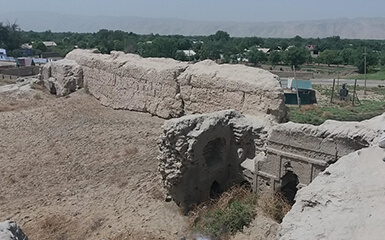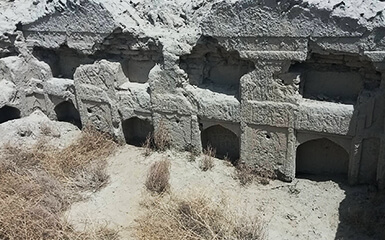Kok Gumbaz
Ajina Teppa
Ancient Panjakent
Anzob Tunnel
Beshkent Qala
Childukhtaron
Khazrati Shokh
Mug Teppa
Gharm Chashma
Hisor Historical
Haji Yaqub mosque
Hazrati-Bobo complex
Lake Iskanderkul
Kalai-Khumb
Karatag
Karon
Khishtin caravanserai
Khorog
Khulbuk
Lake Karakul
Abdullatif Sultan
Madrasai Kuhna
Abu Abdullah Rudaki
Khoja Mashhad
Khudoyor Valami
Makhmudi Azam
Mir Sayyid Ali Hamadani
Muhammed Bashoro
Sheikh Muslihiddin
Nurek Mountain Lake
Pamir
Sarazm
Sari-Khosor
Seven Lakes
Shirkent
Chiluchorchashma
Takht-i Sangin
Beshkent Qala

Beshkent Qala is located in Nosiri Khusrav District. The fort is not far from the Chilucharchashma springs (44 Springs). Built on an artificial hill, there are remnants of mudbrick walls and the remains of a castle. Some carvings can be seen on the outer walls. The castle was in use very late, from the 6th century BC to the 4th century AD and from the 17th to the 20th century AD.
It is one of the best examples of an ancient fort in Southern Tajikistan. It is located just outside the town of Beshkapa, about 10 km west of Shahrtuz. Two sections of the outer brick walls are in very good condition and can be seen from the road. The fort is said to date from the 1600s and was used until the 1920s when it was destroyed during the Soviet Red Army invasion. If you walk over the clay mounds that were once defensive walls, the curved outlines of the old moat can be seen in several places below.
The Beshkent Qala is one of the monuments of the late middle Ages in southern Tajikistan. Its fortifications consist of defensive walls and towers of the Bek residence. In terms of plan, the fortress has a square shape (144x144 m). The Bek chambers consisted of the living quarters of the Bek himself and his wives, a dining room, and a teahouse. On the territory of the fortress, there was a mosque, a prison and stables. By the grandeur and grandeur of the external appearance, the Beshkent fortress is one of the most significant in the architecture of Central Asia.
A number of small fortresses of local princes and high officials have survived in the Pamirs from the 17th-15th centuries. Such fortresses-houses (Kalai Panj, Roshtkala in Shugnan, Bar-Panj in Wakhan, Kalai Boshar in Rushan, etc.) were erected on a hill from raw bricks. There were buildings for guards, barracks, princely chambers, stables, and a household yard. The corners of the walls flanked the towers. From the fortress to the river, there was an underground passage - obduzd.
If you can make a short trip to this site, it will be worth it because it may not be around for much longer.

